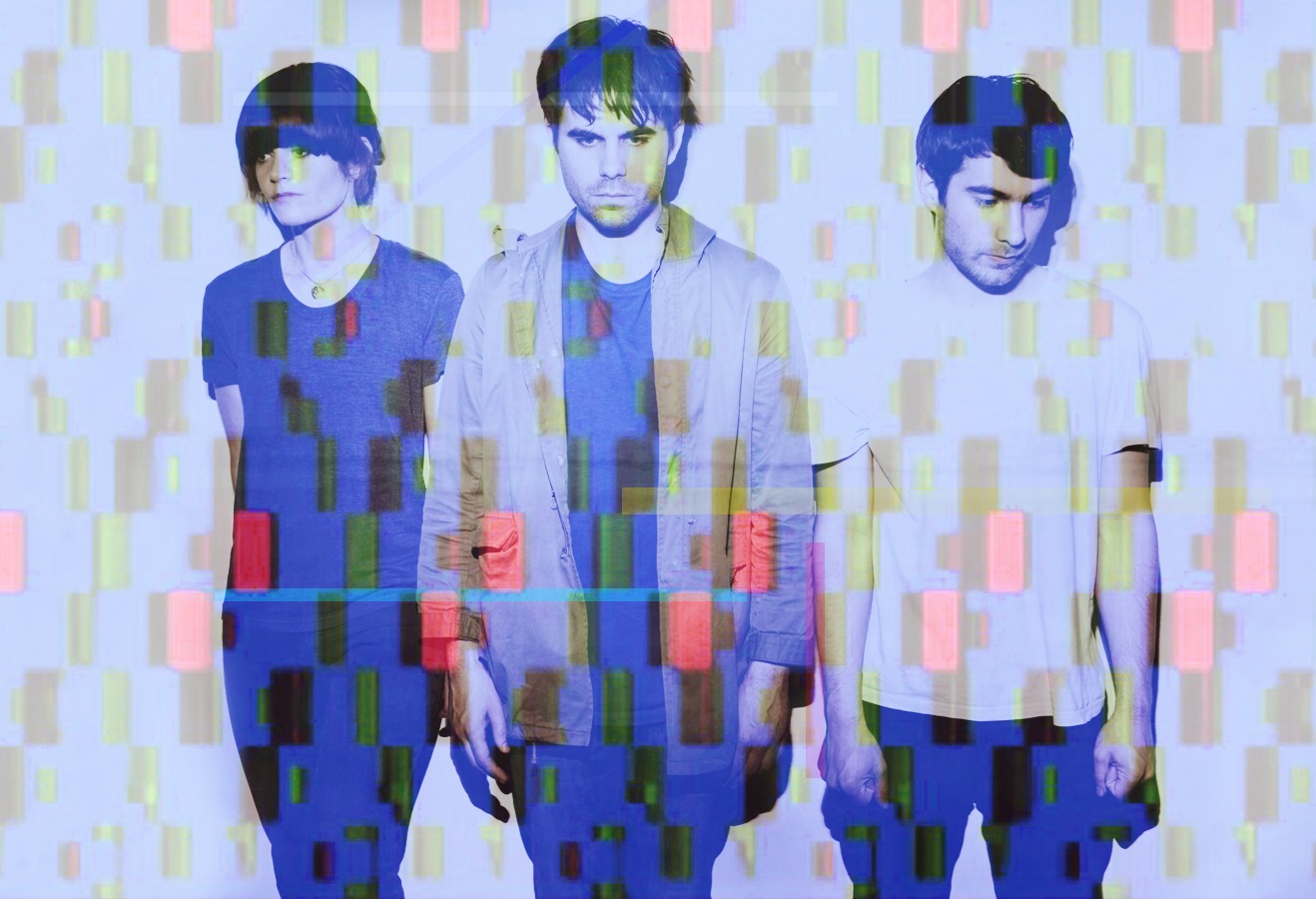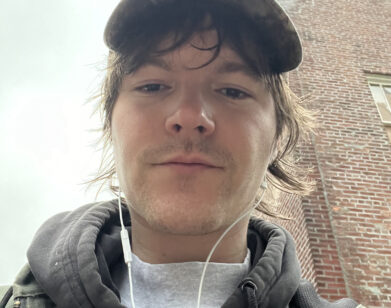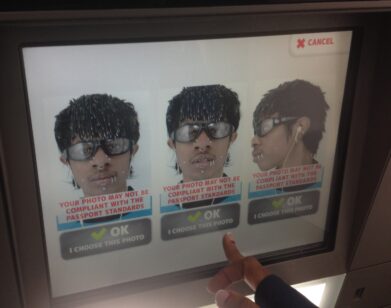Factory Floor Gets to Work

FACTORY FLOOR
Factory Floor may be a bit of an acquired taste—something so complex in flavors and textures that some palates might not be able to take it all in. First, there’s a Giorgio Morodor-style dance, with driving beats, crescendoing percussion, and a nod to early techno. But Dominic Butler’s near-oppressive synths build and decay over the vocals of Nik Void (A.K.A Nik Colk) and her sporadic, droning guitar. Playing on top of the electronics is live drummer Gabriel Gurnsey, giving the band a more organic, spontaneous sound.
The UK-based trio is a bit of a phenomenon overseas, playing to the dystopian crowd at Britain’s Offset Festival and known for being a thinking person’s dance band, adding live elements to their performance. Now, Factory Floor is touring the East Coast for the first time, playing the New York area and appearing at the Portishead-curated ATP Festival this weekend. Don’t worry if you miss it—based on their cult following, work with New Order’s Stephen Morris, and a single to be released by DFA Records, they’ll certainly be stateside again soon.
BRILLSON: So, since this is your first time playing in New York, and the US in general, where would you rather live? Manhattan or Brooklyn?
GURNSEY: Brooklyn!
BUTLER: Yeah, Brooklyn. I don’t know what Manhattan is like. Where would you live?
BRILLSON: Well, I live in Brooklyn. But I’d live there even if I had a choice. So why has it taken you guys so long to get over here?
GURNSEY: I think that now is the right time for us to come over here. We’ve been developing musically for a long time over in the UK. I think it’s a good time… any earlier would have been the wrong time.
COLK: We kind of don’t tour. We do one-off shows. More of events, at things like galleries or warehouses. The touring thing seems to make sense over here though, and it’s great to start in New York, especially with the DFA single coming out. We thought, “Let’s do a few shows and test the water.”
BRILLSON: I’d be curious to see how it turns out and how the US audience reacts. What do you think’ll happen?
BUTLER: The feedback online has been amazing. We’ve been seeing a lot of people really excited about us coming over. We’ve had people asking us when we’re coming over for a while, so I think people are really happy to see we’re finally doing it. It’s quite weird.
COLK: I have no idea how it’ll be!
BUTLER: What do you think?
BRILLSON: Ha! I think there is a lot going on right now with people very earnestly approaching early electronic music in a DIY sense, so I think this is an optimal time for you guys. Can you guys tell me about the DFA single? How did that come about? Why DFA, which has such deep disco and house inspirations?
GURNSEY: The sound has been growing for the past year, and I think where we are now is more sophisticated than we were a year ago. We wanted to move into the dance area a little bit more.
COLK: People like HEALTH and Rapture, and the bands that are on DFA, share our connection between dance and live band. They also have a connection to the past and making it new again. I don’t know, it seemed to fit really well, didn’t it? We wanted to put a single out in the US before we put out an album.
GURNSEY: I saw Shit Robot in Glasgow the other week. And it was really amazing, lights going off, everyone dancing at three in the morning.
BRILLSON: Can you guys walk me through and describe the DFA single?
GURNSEY: Maybe there is a bit more percussion in it. There is an element of that.
COLK: We built it up in our studio, so it really emerged organically.
GURNSEY: But it still came up through experimentation, right?
BRILLSON: You have these long songs that really shift through phases. Is that from a process of experimentation?
BUTLER: When you play live, you are in a certain mind-state. It’s not pressure, but there is an edge to the performance and the way your mind is taking over. It can sometimes spring really interesting ideas.
COLK: We like to take how we work on stage to the recording.
GURNSEY: The DFA track definitely goes through phases, like “Wooden Box” does or “Lion” does. I guess that’s what Factory Floor is: long, drawn-out tracks that go through a bit of a landscape of sounds. But yeah, the DFA track is a bit more focused. It is called “Two Different Ways,” and there is a flip side with an alternate version—we remixed our own track.
BRILLSON: Speaking of which, I have to ask: What was it like to work with Stephen Morris (of New Order)? Did you meet him?
GURNSEY: We spent a lot of time with him.
BUTLER: We went up to his farmhouse. He is a really down-to-earth guy.
GURNSEY: He is still so passionate about music. We had a really nice time in the hills of Macclesfield working together.
COLK: With the tanks! He has a whole farm of antique tanks he has collected. He’s a bit of an eccentric.
BUTLER: It was weird. When we showed up to the train station, I was quite nervous. But there he was, on the platform, waving. I think he was quite nervous as well.
BRILLSON: It’s great to see this cross-generational collaboration.
GURNSEY: I think there is a great crossover. There was a time, about 10 years ago, in the UK and London where young bands were the thing, and there was no one beyond the age of 30. Thank God it’s gone, because it is limiting.
BRILLSON: How did Factory Floor come to be?
BUTLER: I met Gabriel in a recording studio in London. He was in a band, and I was practicing.
GURNSEY: There was a really key point when we all got together in a room where we were a couple practices in, and it just kind of clicked and turned into something where we were like, “Hrm. That’s a bit weird. What the fuck was that?” It went on from there. There was no scene at the time. We were all interested in the same music, art, and videos. We had a lot of mutual love for certain bands.
BRILLSON: Like who?
GURNSEY: Uh-oh. You’ve put me on the spot.
BUTLER: We have a very gibberish-y thing in our head. Certain bands follow certain paths, and I think we just want to explore sounds.
BRILLSON: You guys occupy a certain space between electronic music’s past and the more experimental, more intuitive present. What sorts of choices do you make to interpret the past and also move forward?
BUTLER: I think if you use certain tools, you get certain sounds.
GURNSEY: But there are certain ways to use them. You can play with feedback of a guitar.
COLK: I used to play guitar very straight. But then I decided I wanted to do something different. I wanted to make it very fragmented and abstract. I got really bored about how most people played guitar, and so I played using more instinct, more experimentation. And more electronics. Now I keep thinking, more and more electronics. It’s so amazing to explore different electronic sounds. The way to really define your sound is to really know your own sound, and be confident. I think that’s what we’ve really got, a really good sense of our own electronic sound.
BUTLER: We’ve tried to strip it back to simplicity.
GURNSEY: It’s quite basic, isn’t it? It is just three elements. It might reference early dance music, that type of symmetry.
BRILLSON: When you guys write an intense, layered song like “Wooden Box” or “R E A L L O V E,” what do you imagine the audience doing?
GURNSEY: Absorbing it.
COLK: Taking it all in.
GURNSEY: The intensity we feel in the studio, making it. We want the people in the audience to feel it, that point where all your worries kind of disappear and the music is just there.
BUTLER: There is nothing like a really good night out where you dance completely. And the next day you feel great. There is a massive power in going out and losing yourself.
GURNSEY: Pure escapism. We want to experience that on the stage. The more the crowd gets into it, the more we give back.
FACTORY FLOOR WILL PLAY AT ALL TOMORROW’S PARTIES THIS WEEKEND. FOR MORE ON THE BAND, VISIT THEIR MYSPACE.






